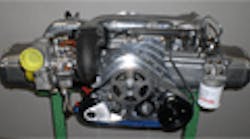Truck OEM Navistar International Corp. is developing new engine architecture with a Michigan-based company that will result in a powerplant that is far lighter than current models, uses 50% fewer parts, and produces much lower exhaust emissions, all with the use of conventional components, materials, and manufacturing processes.
Navistar is working with EcoMotors International of Allen Park, MI, to commercialize what the two companies call a “breakthrough” engine architecture design for the truck market via a turbocharged diesel model.
Using EcoMotors’ “opposed-piston, opposed-cylinder” architecture, or “opoc” for short, Navistar expects to produce light-weight engines that further reduce emissions within the next several years.
EcoMotors, founded in 2008, said its engine design can be used in many forms, including cars, light trucks, commercial vehicles, aerospace, marine, agriculture, auxiliary power units, and generators – basically in any equipment currently powered by conventional gas or diesel models.
The two primary investors in EcoMotors – Khosla Ventures and Microsoft founder Bill Gates – see in this technology a chance to reduce harmful exhaust pollutants without sacrificing engine power.
“[This technology] can provide not only rapid payback but also economic and carbon benefits to large segments of the world's population without the need for subsidies or massive infrastructure investments,” said Vinod Khosla, head of Khosla Ventures.
“Among next-generation propulsion systems, the opoc engine is broadly applicable and can provide lower carbon emissions than almost any other technology,” he added. “We are delighted that Navistar has recognized the game-changing promise of opoc.”
Don Runkle, EcoMotors’s CEO, said the opoc engine comprises two opposing cylinders per module, with a crankshaft between them – with each cylinder containing two pistons moving in opposite directions. This design configuration eliminates the cylinder-head and valve-train components of conventional engines, offering a more efficient, compact and simple core engine structure.
The result is an engine family that is lighter, more efficient and economical, with lower exhaust emissions that can run on almost any fuel, Runkle stressed – gasoline, diesel, natural gas, and even ethanol.
He also pointed out that the key metric for future engine designs is “power density,” for as greater power density is achieved, engines can become smaller, weigh less, cost less to build, and generate lower amounts of internal friction, resulting in greater fuel efficiency, lower emissions, and less heat rejection.
EcoMotors’ design is but one of several new architectures being touted as a way to simultaneously boost fuel efficiency while lowering emissions for a wide range of vehicles.
For several years, the West Springfield, MA-based Scuderi Group has been working to commercialize its “split-cycle” engine design, which divides the four strokes of a conventional combustion cycle over two paired cylinders: one intake/compression cylinder and one power/exhaust cylinder.
By firing after top-dead center, the company said its engine architecture produces more efficient, cleaner combustion with one cylinder and compressed air in the other, while requiring just one crankshaft revolution as opposed to the two required in current engine model – all while purportedly producing more torque than conventional gasoline and diesel engines, the firm said.
The firm contracted with the Southwest Research Institute (SwRI) to conduct extensive computer model tests and vehicle simulations using a 1-liter gasoline-fueled Scuderi prototype in a 2004 Chevrolet Cavalier and found its design consumed 25% less fuel than current platforms for that size of vehicle in tests conducted earlier this year.
The company also expects its naturally-aspirated air-hybrid split-cycle engine design should consume 30% to 36% less fuel under similar drive conditions, according to SwRI’s computer models.
“We expect the efficiencies to continue to climb as modifications are made and new simulations are conducted, including computer modeling of the 2011 Nissan Sentra running with our engine,” said Sal Scuderi, president of the Scuderi Group; a company named after his father, Carmelo Scuderi, who developed this unique combustion process.
These are all part of what EcoMotors’ Runkle characterized as efforts to modernize what he describes as “essentially 19th century internal combustion engine technology” for 21st century needs.
“[Our engine] technology represents a competitive advantage that enables not only enhanced environmental sustainability, but also greater profitability, as we are working to effectively rejuvenate the internal combustion engine for the 21st century,” he said.



